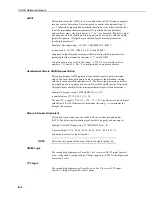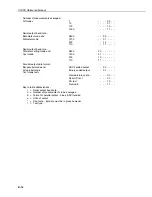
C-1
Appendix C. Binary Telecommunications
The following commands provide the most efficient extraction of data from a datalogger.
They are designed to be used by computer programs which communicate with the datalogger
automatically. To work efficiently these instructions use binary data (including non-printable
characters); they are therefore not suitable for manual interrogation of the datalogger using
a terminal emulator.
The protocols used are not complicated but do require a reasonable knowledge of computer
programming to be able to decode the binary data. These instructions are used by Campbell
Scientific’s PC programs for communications with the dataloggers; there are no other
undocumented instructions which are used. Specifically, data collection by Term,
GraphTerm and Telcom use the F command, and the monitor mode of Term and GraphTerm
use the J and K commands.
An inexperienced user may find the D command for data collection and the I command for
reading Input Storage easier to use in the first instance.
C.1 Telecommunications Commands with Binary
Responses
C.1.1 The F Command
This requests a block of binary data from the datalogger. The data is sent in Final
Storage format and can either be decoded ‘on the fly’ (using user-written code to
decode the data as described in Section C.2), or decoded using the Split program.
After the data the last two bytes sent are a binary checksum. This is a much more
effective checksum than that used for ASCII data transfer. For further details of
this checksum see Section C.3.
Command
Description
[no. of loc.]F
BINARY DUMP — CR10X sends, in Final Storage Format
(binary), the number of Final Storage locations (nnnn)
specified (from current MPTR locations), then Signature (no
prompt).
A 40 second time out timer is reset for each F command. [no.of loc.] must be
≤
65535.
C.1.2 Datalogger J (2413J & 3142J) and K Commands
The older 3142J command is used to toggle datalogger user flags and ports,
request final storage data, and to establish the input locations returned by the K
command (see below). The newer 2413J was added to later operating systems (see
note on datalogger OS versions below) and is identical to the 3412J command
except that when the datalogger receives the 2413J command, it ignores the bytes
that toggle flags and ports. Setting ports and flags in the newer operating systems
is done with the U command which adds checksums for improved reliability.
The 2413J / 3142J and K commands are primarily used for reading data from the
datalogger’s Input Storage. They also allow you to:
•
Read (but not change or set) the datalogger’s real-time clock
















































